6.7: Opportunities, Responsibilities, and Obligations of Citizenship
- Page ID
- 5874
\( \newcommand{\vecs}[1]{\overset { \scriptstyle \rightharpoonup} {\mathbf{#1}} } \)
\( \newcommand{\vecd}[1]{\overset{-\!-\!\rightharpoonup}{\vphantom{a}\smash {#1}}} \)
\( \newcommand{\id}{\mathrm{id}}\) \( \newcommand{\Span}{\mathrm{span}}\)
( \newcommand{\kernel}{\mathrm{null}\,}\) \( \newcommand{\range}{\mathrm{range}\,}\)
\( \newcommand{\RealPart}{\mathrm{Re}}\) \( \newcommand{\ImaginaryPart}{\mathrm{Im}}\)
\( \newcommand{\Argument}{\mathrm{Arg}}\) \( \newcommand{\norm}[1]{\| #1 \|}\)
\( \newcommand{\inner}[2]{\langle #1, #2 \rangle}\)
\( \newcommand{\Span}{\mathrm{span}}\)
\( \newcommand{\id}{\mathrm{id}}\)
\( \newcommand{\Span}{\mathrm{span}}\)
\( \newcommand{\kernel}{\mathrm{null}\,}\)
\( \newcommand{\range}{\mathrm{range}\,}\)
\( \newcommand{\RealPart}{\mathrm{Re}}\)
\( \newcommand{\ImaginaryPart}{\mathrm{Im}}\)
\( \newcommand{\Argument}{\mathrm{Arg}}\)
\( \newcommand{\norm}[1]{\| #1 \|}\)
\( \newcommand{\inner}[2]{\langle #1, #2 \rangle}\)
\( \newcommand{\Span}{\mathrm{span}}\) \( \newcommand{\AA}{\unicode[.8,0]{x212B}}\)
\( \newcommand{\vectorA}[1]{\vec{#1}} % arrow\)
\( \newcommand{\vectorAt}[1]{\vec{\text{#1}}} % arrow\)
\( \newcommand{\vectorB}[1]{\overset { \scriptstyle \rightharpoonup} {\mathbf{#1}} } \)
\( \newcommand{\vectorC}[1]{\textbf{#1}} \)
\( \newcommand{\vectorD}[1]{\overrightarrow{#1}} \)
\( \newcommand{\vectorDt}[1]{\overrightarrow{\text{#1}}} \)
\( \newcommand{\vectE}[1]{\overset{-\!-\!\rightharpoonup}{\vphantom{a}\smash{\mathbf {#1}}}} \)
\( \newcommand{\vecs}[1]{\overset { \scriptstyle \rightharpoonup} {\mathbf{#1}} } \)
\( \newcommand{\vecd}[1]{\overset{-\!-\!\rightharpoonup}{\vphantom{a}\smash {#1}}} \)
\(\newcommand{\avec}{\mathbf a}\) \(\newcommand{\bvec}{\mathbf b}\) \(\newcommand{\cvec}{\mathbf c}\) \(\newcommand{\dvec}{\mathbf d}\) \(\newcommand{\dtil}{\widetilde{\mathbf d}}\) \(\newcommand{\evec}{\mathbf e}\) \(\newcommand{\fvec}{\mathbf f}\) \(\newcommand{\nvec}{\mathbf n}\) \(\newcommand{\pvec}{\mathbf p}\) \(\newcommand{\qvec}{\mathbf q}\) \(\newcommand{\svec}{\mathbf s}\) \(\newcommand{\tvec}{\mathbf t}\) \(\newcommand{\uvec}{\mathbf u}\) \(\newcommand{\vvec}{\mathbf v}\) \(\newcommand{\wvec}{\mathbf w}\) \(\newcommand{\xvec}{\mathbf x}\) \(\newcommand{\yvec}{\mathbf y}\) \(\newcommand{\zvec}{\mathbf z}\) \(\newcommand{\rvec}{\mathbf r}\) \(\newcommand{\mvec}{\mathbf m}\) \(\newcommand{\zerovec}{\mathbf 0}\) \(\newcommand{\onevec}{\mathbf 1}\) \(\newcommand{\real}{\mathbb R}\) \(\newcommand{\twovec}[2]{\left[\begin{array}{r}#1 \\ #2 \end{array}\right]}\) \(\newcommand{\ctwovec}[2]{\left[\begin{array}{c}#1 \\ #2 \end{array}\right]}\) \(\newcommand{\threevec}[3]{\left[\begin{array}{r}#1 \\ #2 \\ #3 \end{array}\right]}\) \(\newcommand{\cthreevec}[3]{\left[\begin{array}{c}#1 \\ #2 \\ #3 \end{array}\right]}\) \(\newcommand{\fourvec}[4]{\left[\begin{array}{r}#1 \\ #2 \\ #3 \\ #4 \end{array}\right]}\) \(\newcommand{\cfourvec}[4]{\left[\begin{array}{c}#1 \\ #2 \\ #3 \\ #4 \end{array}\right]}\) \(\newcommand{\fivevec}[5]{\left[\begin{array}{r}#1 \\ #2 \\ #3 \\ #4 \\ #5 \\ \end{array}\right]}\) \(\newcommand{\cfivevec}[5]{\left[\begin{array}{c}#1 \\ #2 \\ #3 \\ #4 \\ #5 \\ \end{array}\right]}\) \(\newcommand{\mattwo}[4]{\left[\begin{array}{rr}#1 \amp #2 \\ #3 \amp #4 \\ \end{array}\right]}\) \(\newcommand{\laspan}[1]{\text{Span}\{#1\}}\) \(\newcommand{\bcal}{\cal B}\) \(\newcommand{\ccal}{\cal C}\) \(\newcommand{\scal}{\cal S}\) \(\newcommand{\wcal}{\cal W}\) \(\newcommand{\ecal}{\cal E}\) \(\newcommand{\coords}[2]{\left\{#1\right\}_{#2}}\) \(\newcommand{\gray}[1]{\color{gray}{#1}}\) \(\newcommand{\lgray}[1]{\color{lightgray}{#1}}\) \(\newcommand{\rank}{\operatorname{rank}}\) \(\newcommand{\row}{\text{Row}}\) \(\newcommand{\col}{\text{Col}}\) \(\renewcommand{\row}{\text{Row}}\) \(\newcommand{\nul}{\text{Nul}}\) \(\newcommand{\var}{\text{Var}}\) \(\newcommand{\corr}{\text{corr}}\) \(\newcommand{\len}[1]{\left|#1\right|}\) \(\newcommand{\bbar}{\overline{\bvec}}\) \(\newcommand{\bhat}{\widehat{\bvec}}\) \(\newcommand{\bperp}{\bvec^\perp}\) \(\newcommand{\xhat}{\widehat{\xvec}}\) \(\newcommand{\vhat}{\widehat{\vvec}}\) \(\newcommand{\uhat}{\widehat{\uvec}}\) \(\newcommand{\what}{\widehat{\wvec}}\) \(\newcommand{\Sighat}{\widehat{\Sigma}}\) \(\newcommand{\lt}{<}\) \(\newcommand{\gt}{>}\) \(\newcommand{\amp}{&}\) \(\definecolor{fillinmathshade}{gray}{0.9}\)
You have probably heard the saying, "Get a life!". An important part of your life, both now and in the future is your civic life. What is your civic life? Civics refer to the political rights and responsibilities of citizenship. Political rights are powers or privileges to which all citizens are due or entitled. Political responsibilities refer to obligations and actions regarding the exercise of political rights for the betterment of society. An important political right is the right to vote, a political responsibility directly associated with this right is deciding whether and how to vote.
Opportunities of U.S. Citizenship
According to the government publication, "A Guide for Naturalization", the Constitution and laws of the United States give many rights to both citizens and non-citizens living in the United States. However, some rights are only for citizens. These opportunities include:
Voting - Only U.S. citizens can vote in Federal elections. Most states also restrict the right to vote, in most elections, to U.S. citizens.
Bringing family members to the U.S. - Citizens generally get priority when petitioning to bring family members permanently to this country.
Obtaining citizenship for children born abroad to a U.S. citizen - In most cases, a child born abroad to a U.S. citizen is automatically a U.S. citizen.
Traveling with a U.S. passport - A U.S. passport allows you to get assistance from the government when outside the U.S.
Becoming eligible for Federal jobs - Most jobs with government agencies require U.S. citizenship.
Becoming an elected official - Many elected offices in this country require U.S. citizenship.
Showing your patriotism - In addition, becoming a U.S. citizen is a way to demonstrate your commitment to your new country.
Responsibilities of U.S. Citizenship
Representative democracy cannot work effectively without the participation of informed citizens, however. Engaged citizens familiarize themselves with the most important issues confronting the country and with the plans different candidates have for dealing with those issues. Then they vote for the candidates they believe will be best suited to the job, and they may join others to raise funds or campaign for those they support. They inform their representatives how they feel about important issues. Through these efforts and others, engaged citizens let their representatives know what they want and thus influence policy. Only then can government actions accurately reflect the interests and concerns of the majority. Even people who believe the elite rule government should recognize that it is easier for them to do so if ordinary people make no effort to participate in public life.
Support and defend the Constitution.
Stay informed of the issues affecting your community.
Participate in the democratic process.
Respect and obey federal, state, and local laws.
Respect the rights, beliefs, and opinions of others.
Participate in your local community.
Pay income and other taxes honestly, and on time, to federal, state, and local authorities.
Serve on a jury when called upon.
Defend the country if the need should arise.
Voting
Since voting is constitutionally assigned to the states, each of the states is allowed to create its own voter registration laws and procedures (subject the federal oversight and Constitutional requirements). In most states, the first step in the voting process is registration. To be eligible to register to vote, the individual must meet three basic requirements: (1) be at least 18 years of age at the time of the next election, (2) being a U.S. citizen and (3) be a resident of the jurisdiction where the individual is registering. Under federal law, every state must allow residents to register to vote at least 30 days before Election Day, though many states extend the deadline to register. Additionally, in some states individuals who have been convicted of a felony or have been found by a court to be incompetent may be ineligible to vote. For more information on voter registration eligibility in your state, call 1-866-OUR-VOTE.
There are many ways to register to vote. The National Voter Registration Act of 1993 (“the Motor Voter Act”) offers individuals the opportunity to register to vote when they apply for or renew a driver’s license, and requires states to offer voter registration at all offices that provide public assistance and state-funded programs to persons with disabilities.
A voter may use the federal mail-in form, which every state must accept and use and includes instructions for where to send it in each state. A person who registered to vote by mail and who is voting for the first time in a federal election must provide a form of voter identification, either a photo copy when they registered by mail or provide the identification in person when they go to go. Acceptable forms of identification may include a current and valid photo ID or paycheck, bank statement, utility bill, or government document with the voter’s full name and voting address. In some states, identification required for first-time voters may be stricter.
Some states have begun making it harder for people to register to vote, often in the name of preventing voter fraud. Even though such voter impersonation fraud is practically nonexistent, voter registration systems kept more than two million people from voting in 2008. States have begun to create new restrictions on voter registration drives, leading some community-based organization to stop voter registration drives altogether. These laws can lead to a big drop in the number of newly registered voters, especially for minority voters.
In addition to new restrictions on the ability to register, some states have also begun aggressive “purge” campaigns which occur when states remove voters from the voter rolls. Though purging voter rolls can be a legitimate state election activity to maintain current and accurate voter rolls, when the process is not done properly eligible, registered voters can end up being purged. Voters check their voter registration status to make sure that they have not been inadvertently removed from the voter rolls.
Many issues impact voter registration like inadequate resources, clerical errors and failures to timely notify registrants of problems with their registration forms. In recent elections, jurisdictions have not scheduled sufficient staff to work on the days prior to the registration deadline when demand for services is heightened. Additionally, elections office employees often make errors while inputting registration data into the jurisdiction’s database. These errors create problems for voters on Election Day, especially with respect to voter identification. Furthermore, elections employees frequently fail to timely notify registrants of errors or omissions in their applications. This means the individual does not have an opportunity to correct his/her registration and is subsequently ineligible to vote.
Video Report: Voter Turnout in 2014 Lowest Since World War II
Voter turnout is the percentage of eligible voters who cast a ballot in an election. "Eligible voters" are defined differently in different countries, and the term should not be confused with the total adult population. After increasing for many decades, there has been a trend of decreasing voter turnout in most established democracies since the 1960s. In general, low turnout may be due to disenchantment, indifference, or contentment. Low turnout is often considered to be undesirable, and there is much debate over the factors that affect turnout and how to increase it. In spite of significant study devoted to the issue, scholars are divided on reasons for the decline. The causes of decreasing turnout have been attributed to a wide array of economic, demographic, cultural, technological, and institutional factors. There have been many efforts to increase turnout and encourage voting. Many Americans believe that it is a civic responsibility to vote, and the U.S. Citizenship Resource Center lists it as a responsibility to ensure that America remains a free and prosperous nation.
Video: Voter Turnout Traditionally Low in the U.S.
In each nation, some parts of society are more likely to vote than others. In high-turnout nations, these differences tend to be limited: as turnout approaches 90 percent, it becomes difficult to find differences of much significance between voters and nonvoters. In low turnout nations, however, the differences between voters and non-voters can be quite marked. Socioeconomic factors significantly affect whether or not individuals voting tendencies. The most important socioeconomic factor in voter turnout is education. The more educated a person is, the more likely he or she is to vote, even when controlling for other factors such as income and class that are closely associated with education level .
Why do Americans vote in small numbers? Political scientists have suggested a number of reasons:
- Inconvenience: For many, getting to the polling place on election day is very difficult: Many people have to work, and some have trouble getting to their precinct.
- Registration: All voters must register ahead of the election (sometimes a month or more in advance); the registration process can be confusing and at times difficult to follow.
- Similarity of the parties: Some citizens believe the parties are very similar, so voting will not make a difference
- Alienation: People do not vote because they feel that the government does not care about them or listen to their concerns.
- Frequency of elections: Americans hold elections more frequently than most other democracies; voters find it difficult to vote on so many different days.
- Lack of competitiveness: Many races in the United States are very lopsided, so voters are likely to stay home, thinking the outcome is a foregone conclusion. Some people argue that low turnout rewards the Republican Party in particular because minorities, who tend to vote Democrat, are the least likely to vote. Others argue that election outcomes would be roughly the same even if everyone voted because the preferences of nonvoters are similar to those of voters.
Some scholars and pundits fret over low turnout, convinced that low turnout undermines democracy. Democracy is government by the people, they argue, and when people do not vote, they give up their part of popular sovereignty. Low turnout also reflects a strong sense of alienation among the public, a bad sign for America’s legitimacy. Other scholars argue the opposite. Low turnout is a sign of a healthy democracy because it reflects satisfaction with the government. According to this view, people only vote when they feel threatened or angered about an issue. People who do not vote, then, are content with the status quo.
Source: SparkNotes Study Guide – American Government and Politics
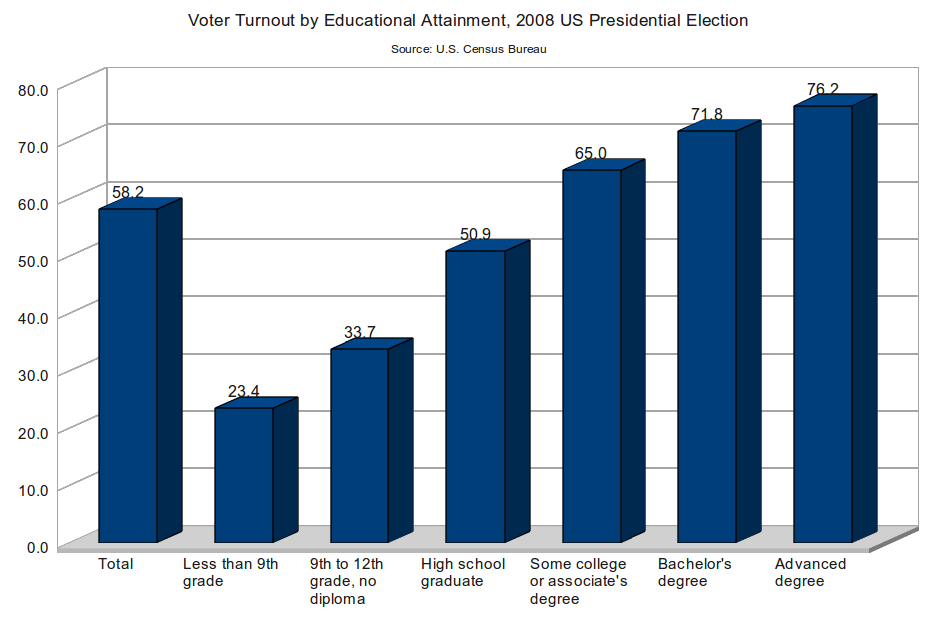
Video: Demographics and Voting Behavior:
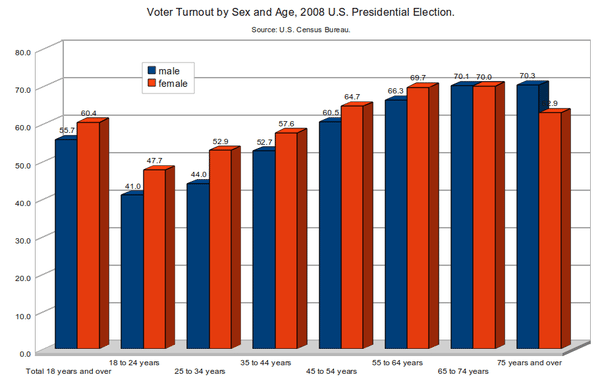
There is some debate over the effects of ethnicity, race, and gender on voter turnout. While women are generally as likely as men to vote in developed countries, women are underrepresented in political positions. Women make up a very small percentage of elected officials, both at local and national levels. In the U.S., for instance, in the 109th Congress (2005-2007) there were only 14 female Senators (out of 100) and 70 Congressional Representatives (out of 435).
Age is another crucial factor in determining voter turnout. Young people are much less likely to vote than are older people, and they are less likely to be politicians. The lower voting rates of young people in the U.S. help explain why things like Medicare and Social Security in the U.S. are facing looming crises: the elderly will retain many of the benefits of these programs and are unwilling to allow them to be changed even though young people will be the ones to suffer the consequences of these crises.
Generally, racial and ethnic minorities are less likely to vote in elections and are also underrepresented in political positions. If blacks were represented in proportion to their numbers in the U.S., there should be 12 senators and 52 members of the House. In 2009, there was one black senator (Roland Burris) and 39 members of the House. In 2010, the number in the House increased slightly to 41 (7.8 percent) but remained at just 1 percent of the Senate.
Political power is also stratified through income and education. Wealthier and more educated people are more likely to vote. Additionally, wealthier and more educated people are more likely to hold political positions. In the 2004 U.S. presidential election, the candidates, John Kerry, and George W. Bush, were both Yale University alumni. John Kerry was a lawyer and George W. Bush had an MBA from Harvard. Both were white, worth millions of dollars, and came from families involved in politics.
Source: Boundless. “Voting Behavior.” Boundless Sociology. Boundless, 14 Nov. 2014. Retrieved 25 Feb. 2015 from https://www.boundless.com/sociology/textbooks/boundless-sociology-textb ook/government-15/the-u-s-political-system-116/voting-behavior-646-7854/
High voter turnout is often considered to be desirable, though among political scientists and economists specializing in public choice, the issue is still debated. A high turnout is generally seen as evidence of the legitimacy of the current system. Assuming that low turnout is a reflection of disenchantment or indifference, a poll with very low turnout may not be an accurate reflection of the will of the people. On the other hand, if low turnout is a reflection of contentment of voters about likely winners or parties, then low turnout is as legitimate as high turnout, as long as the right to vote exists. Still, low turnouts can lead to unequal representation among various parts of the population. In developed countries, non-voters tend to be concentrated in particular demographic and socioeconomic groups, especially the young and the poor.
Many causes have been proposed for this decline; a combination of factors is most likely. When asked why they do not vote, many people report that they have too little free time. However, over the last several decades, studies have consistently shown that the amount of leisure time has not decreased. Wealth and literacy have some effect on turnout but are not reliable measures. For example, the United Nations Human Development Index shows some correlation between higher standards of living and higher turnout. The age of a democracy is also an important factor. Elections require considerable involvement by the population, and it takes some time to develop the cultural habit of voting, and the associated understanding of and confidence in the electoral process. Demographics also have an effect. Older people tend to vote more than youths, so societies where the average age is somewhat higher, such as Europe; have higher turnouts than somewhat younger countries such as the United States.
Institutional factors have a significant impact on voter turnout. Rules and laws are also generally easier to change than attitudes, so much of the work done on how to improve voter turnout looks at these factors. Making voting compulsory has a direct and dramatic effect on turnout. Simply making it easier for candidates to stand through easier nomination rules is believed to increase voting. Ease of voting is a factor in rates of turnout. In the United States and most Latin American nations, voters must go through separate voter registration procedures before they are allowed to vote. This two-step process quite clearly decreases turnout. U.S. states with no, or easier, registration requirements have larger turnouts.
In politics, voter fatigue is the apathy that the electorate can experience under certain circumstances, one of which could be (in exceptional circumstances) that they are required to vote too often. Voter fatigue and voter apathy should be distinguished from what arises when voters are not allowed or unable to vote, or when disenfranchisement occurs. Similarly, voter suppression is a strategy to influence the outcome of an election by discouraging or preventing people from exercising their right to vote. It is distinguished from political campaigning in that campaigning attempts to change likely voting behavior by changing the opinions of potential voters through persuasion and organization.
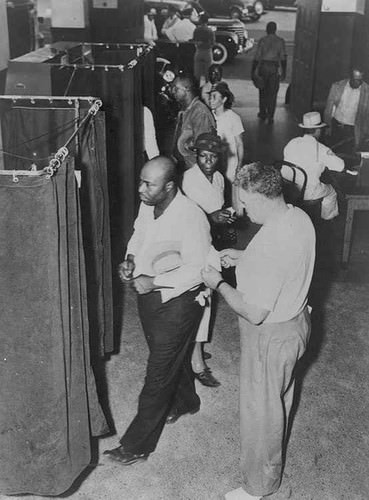
Voter suppression instead attempts to reduce the number of voters who might vote against the candidate or proposition advocated by the suppressors. This suppression can be in the form of unfair tests or requirements to vote. For example, in the southern United States before and during the civil rights movement, white southerners used many methods to prevent minorities from voting. These included literacy tests, a poll tax, and if all else failed intimidation by threats of violence. The Civil Rights Act of 1964 put a stop to literacy tests and any other methods of preventing people from voting. Excluding convicted from voting and re-including them only on case-by-case decisions by State Governors, as is the case in numerous U.S. states, can lead to voter suppression and can induce biased voting, as there can be a class bias in the state's decision.
|
Many Americans don't vote because they think their vote doesn't count. This is a common excuse that's rooted in the belief that the Electoral College chooses the President, not the voters. In reality, the popular vote in each state determines which candidate the Electoral College endorses for that state. Therefore, your vote does count within your state, and you should get out and exercise your right to vote. |
|
|
Americans are busy people. Work, family, and other life obligations tend to get in the way of civic duties like voting. There's no doubt that voting presents scheduling challenges, but is that really a good excuse not to vote? After all, people all over the world have fought and died for the right to vote. The least we can do is carve out a few minutes to go to a polling center and cast our vote. |
|
|
Voting registration can be confusing, especially for citizens that have moved from county to county or from state to state. But registration itself is painless and takes little more than the presentation of identification. Therefore, to prevent registration requirements from preventing you from voting, make it a point to update your voter registration every time you move. |
|
|
Apathy |
Americans have a reputation for being apathetic to politics and voting in general, but politics, in particular, can cause Americans' eyes to glaze over. Many people don't like the partisan bickering underlying the voting process, and this is a valid concern. However, if you are too apathetic to vote, you should also be sure to hold your complaints about the way things are run. If you don't voice your opinion by voting, you shouldn't have the right to voice your complaints when things don't go the way you want them to. |
|
Voting lines can sometimes be long, and for busy people waiting in line is a horrible waste of time and energy. But in reality, voting lines are seldom long, even for high-profile presidential races. With the advent of new technology, voting is becoming easier and more efficient than ever before, and this allows voters to get in and out without having to wait in long lines. This excuse is becoming less and less relevant as time goes on. |
|
|
Don't like the candidates |
Politicians are sometimes easy to dislike. Their flaws are often aired publicly for the entire world to see, and many people generally distrust politicians based on this information. But even if you don't particularly like any of the candidates, do you really know them? And should it matter whether you like them or not? Perhaps a politician's stance on issues important to you is more important than whether or not they are likable. Even if it's choosing the lesser of two or more evils in your eyes, voting is still an important way for you to voice your opinion about the subjects you care about most. |
|
Can't get to the polls |
Getting to polling locations can be a hassle, especially for the disabled, the sick, and people without transportation. In addition, voting becomes even more difficult for those citizens who are temporarily out of the country on vacation or business. But advocacy groups are making it much easier to get to the polls, even for those with special needs. In addition, absentee voting allows those people who are temporarily out of the country to cast their vote remotely. As a result, claiming that you can't get to the polls is not a very good excuse not to vote. |
Source: http://www.zencollegelife.com/the-7-reasons-most-americans-dont-vote/
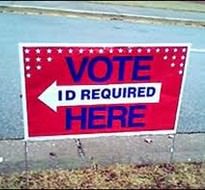
- While voter ID has been one of the hottest topics in elections policy for the last several years, its legacy extends back to 1950. That was when South Carolina became the first state to request that voters show some kind of identification document at the polls. No photo was required—just a document bearing the voter’s name. In 1970, Hawaii joined South Carolina with a voter ID requirement. Texas (1971), Florida (1977), and Alaska (1980) rounded out the first five. In some states the request was for an ID with a photo; in others, any document, with or without a photo, was fine. In all these states, provisions existed for voters to be able to cast a regular ballot even if they did not have the requested ID.
Over time, and with little fanfare, more states began to ask voters to present an identification document. By 2000, 14 states did so. These states had Democratic and Republican majorities. In the 2000s, voter ID as an issue began to take center stage. The Commission on Federal Election Reform (aka the Carter-Baker Commission), in 2005 made a bipartisan recommendation for voter identification at the polls.
Soon thereafter, Georgia and Indiana pioneered a new, “strict” form of voter ID. Instead of requesting an ID, these states required an ID. If a voter did not have the required ID at the polling place, he or she voted on a provisional ballot, and that ballot was not to be counted unless the voter returned within the next few days to an elections office and showed the required ID. These were first implemented in 2008 (after Indiana’s law was given the go-ahead by the U.S. Supreme Court, in Crawford v. Marion County).
In 2011, 2012 and 2013, the pace of adoption accelerated. States without ID requirements continued to adopt them, and states that had less-strict requirements adopted stricter ones. Many of the stricter laws were challenged in court, with mixed results. Following is a chart with the progression of legislation on voter identification from 2000 to 2014, and below is a detailed timeline of enacted legislation.
What’s wrong with Voter ID laws? Voting law opponents contend these laws disproportionately affect elderly, minority and low-income groups that tend to vote Democratic. Obtaining photo ID can be costly and burdensome, with even free state ID requiring documents like a birth certificate that can cost up to $25 in some places. According to a study from NYU's Brennan Center, 11 percent of voting-age citizens lack necessary photo ID while many people in rural areas have trouble accessing ID offices. During closing arguments in a recent case over Texas's voter ID law, a lawyer for the state brushed aside these obstacles as the "reality to life of choosing to live in that part of Texas."
Attorney General Eric Holder and others have compared the laws to a poll tax, in which Southern states during the Jim Crow era imposed voting fees, which discouraged blacks, and even some poor whites -- until the passage of grandfather clauses -- from voting.
Given the sometimes costly steps required to obtain needed documents today, legal scholars argue that photo ID laws create a new "financial barrier to the ballot box."
Source: by Suevon Lee, ProPublica, Nov. 5, 2012, http://www.propublica.org/article/everyt hing-youve-ever-wanted-to-know-about-voter-id-laws/single#republish. Accessed Feb. 26, 2015.
Source: National Council of State Legislatures,http://www.ncsl.org/research/elections-and -campaigns/voter-id.aspx. Accessed February 26, 20
Some political scientists contend that people engage in retrospective voting: Voters use the past few years to decide how to vote. In general, if a voter thinks that the country has done well over the last few years, he or she votes for the party in power. If the voter believes that the country has done poorly, he or she votes for the opposition party. Other scholars argue that Americans engage in prospective voting, which is voting with an eye to the future. People vote for the candidates that they believe will do the most to help the country in the next few years.
Source: SparkNotes Study Guide – American Government and Politics. http://www.sparknotes. com/us-government-and-politics/american-government/the-political-process/section3.rhtml
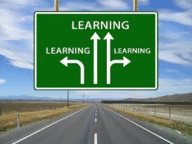
Study/Discussion Questions
1. List and describes the steps in registering to vote.
2. What do you see as the most significant barrier(s) to voter registration among young adults?
3 What impact do other demographic factors such as race, ethnicity, and gender have on voter registration?
4. What factors help explain low turnout rates in the United States? What policies would you recommend in response to these factors and trends?
5. Do you consider voter ID laws as barriers to voter participation or a means to protect from voter fraud? Explain your answers by researching the topic online.

